Scroll through the lesson and click on notation/video/audio links to load the interactive players.
Please subscribe to get full access to all lessons for only $7.95/month PLUS 1 week free trial.

Riff Interactive lessons are
LESS expensive and
MORE interactive than alternatives!
More Info
|
|
| Lesson Subject:
Rolling Stones Style |
| What you learn:
Rhythm & Chords (C) |
| Michael: Michael Johnson |
Michael: This interactive lesson will cover rhythm patterns of the Rolling Stones, ala Keith
Richards! Many guitarists consider Keith
Richards one of the top players of the rhythm guitar! Richard's style features a lazy sounding rhythm
style and very interesting chord inversions that almost sounds like he's playing
rhythm and lead at the same time. Rhythm playing is essential to any
guitarist, these patterns affect both our strumming and lead playing. Here's a
sample of the rhythm patterns you'll learn:
Michael: Without a
strong rhythm, you solos can even sound sterile, most of what you'll learn
in this lesson is:
1. I, IV, V progression in the key of C
2.
Variation on that pattern
3. Playing chord inversions and single lines off
each chord
This is fun stuff, I still have fun
playing rhythm patterns like this even after all the years I've been playing,
let's get started. Here's the notes of a C I, IV, V:
Michael: You have C (I), D, E, F (IV), G
(V), A, B now these same notes
can be played on the lower strings. Here's the notes on the lower
strings.
Michael: Here's the I (C), IV (F), V (G) using the lower strings. Let's play our first
rhythm pattern:
Michael:
This is a standard rhythm practice, soon I'll add more to this pattern. Here's
the jam track to play over:
Looping Jam Track 1
Michael:
Simple but very
effective. In this progression we have I, IV, I, V, I. Now you
can add a few inversions to the chord:
Michael: In this example you add a sus4 to each chord. Here's the pictures for each
chord:
C Barre (3rd fret/5th
string)
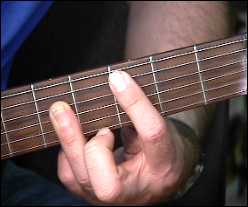
C sus 4
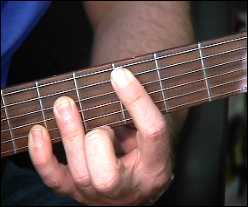
Michael:
That's the C and C sus4 (suspended 4
chord), just add the
little finger to the C.
ECid: Sounds just like the
stones
F Major
Barre
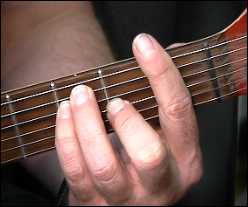
Michael:
Here's the F and F sus4, but is
actually fingered a F7 sus4. I fingerpick the chords, which helps to leave out
the b7 note.
G Major Barre (3rd
fret)
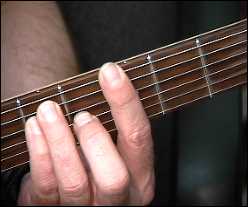
G sus 4
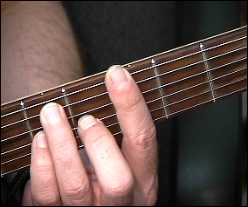
Michael:
That's the V chord G and G sus4 (or G7
sus4). Here's how I finger pick the chords; thumb on 6th, 1st finger on 4th
finger, etc:
Fingerpick
Technique

Michael:
Finger picking gives the chords a unique
attack and allows you to play various chord inversions with ease. Let's try
another rhythm pattern:
ECid:
Does Keith Richards finger
pick?
Michael: Ecid, he does at times.
Richards has a very unique style, he study many of the great blues players who fingerpicked.
Notice the inversions which actually turn out to be relative to other
chords. Example C, then the F which actually has the major 3rd for the top
of the chords:
C Major Barre
(3rd fret/5th string)
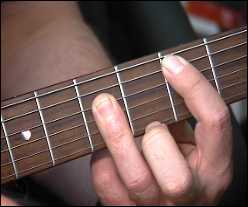
Em6
(inversion)
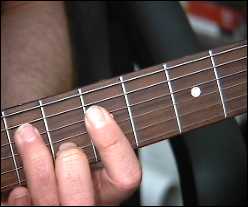
Michael: Notice how you hand shifts? The 1st
finger replaces the 3rd finger on the 5th fret. Notice the min 6 inversion
on the F and G chords:
F Major
Barre
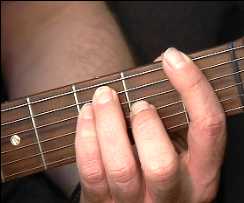
Dm6
(inversion)
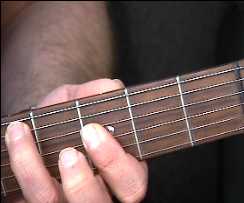
Michael: Notice how the 1st finger moves to the
3rd fret. The same pattern work for the G as well. Now let's try our next
Rhythm:
Michael: In this pattern you play the major chord
then slide from the Maj 2nd -> Maj 3rd note off each chord and play a portion
of the 5 chord (root, 5). Make sure you're playing over the jam track. That's
where the real magic is for playing these lines!!!
C Major Barre (3rd fret/5th
string)
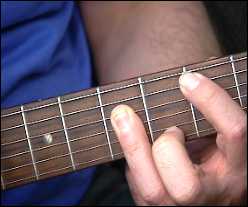
3rd finger
slides from 3rd to 5th fret
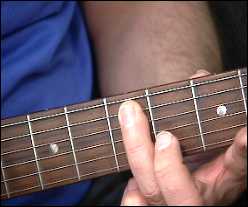
Barre 1st
finger - 5th fret/3rd & 4th
strings

Michael:
Notice how the slide and fingerings set
up the pattern. Simple, but very effective! Have any of
you played these kind of rhythm patterns before? Here's our next rhythm
pattern.
Michael: Now this is when things get very cool, try using variations of all the patterns
that you've played earlier. Here's a live track of me making up various
patterns:
Teacher
Sample 1
Michael:
Notice I play the slide/chord inversion pattern (C), then play F sus4, then
back to the first rhythm patterns.
Teacher Sample 2
Michael:
The second pattern is me playing the I (C) and C sus4, then IV (F) with the
slide/chord inversion pattern, then back to all suspended chords for the rest of
the progression. See if finger picking will help change your sound. We'll
continue more of this lesson next lesson and add
more lead patterns between the chords.
|
<< load notation from left
|
|
<< load audio from left
|
<< load audio from left
|